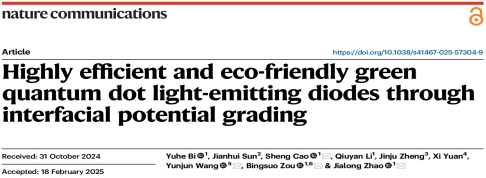Recently, the nanophotonics research team at Guangxi University has made significant progress in the research of high-efficiency, eco-friendly quantum dot light-emitting diodes (QLEDs). The groundbreaking study, titled “Highly Efficient and Eco-Friendly Green Quantum Dot Light-Emitting Diodes Through Interfacial Potential Grading”, has been published in the prestigious international journal Nature Communications. The lead author is Bi Yuhe, a 2022 Ph.D. candidate from the School of Physical Science and Technology, with corresponding authors including Prof. Dr. Cao Sheng and Prof. Dr. Zhao Jialong from the same school, Prof. Dr. Zou Bingsuo from the School of Resources, Environment, and Materials, and Dr. Wang Yunjun from Suzhou Mesolight (Xingshuo Nanotech) Co., Ltd. Guangxi University serves as the first and corresponding affiliation for this research.

With the rapid advancement of display technologies, QLEDs have emerged as strong contenders for next-generation high-performance displays. In recent years, eco-friendly quantum dots free of heavy metals have garnered widespread attention due to environmental concerns and the demand for large-scale commercialization. However, while significant strides have been made in red and blue eco-friendly QLEDs, green QLEDs remain hindered by technical bottlenecks, primarily due to their high non-radiative recombination rates, particularly Auger recombination, which limits their external quantum efficiency (EQE) to below 20%, severely impeding commercial viability.

Addressing this challenge, the research team leveraged Guangxi’s abundant nonferrous metal resources to innovatively develop a high-performance eco-friendly zinc selenide telluride (ZnSeTe) QLED fabrication technique. The study focuses on optimizing the interfacial potential structure of ZnSeTe quantum dots to enhance luminescent performance. By precisely engineering interfacial potential gradients, the team effectively reduced lattice strain and structural defects, thereby suppressing non-radiative recombination processes, especially Auger recombination. The results demonstrate that ZnSeTe-based green QLEDs employing this interfacial optimization strategy achieved a record EQE of 21.7% at a high luminance of 5,963 cd m?2, alongside a maximum luminance of 52,040 cd m?2 under a driving voltage of 5.4 V. This work substantially advances the performance of eco-friendly green QLEDs, elucidates the critical relationship between interfacial potential modulation and device efficiency, and establishes a foundational pathway for developing high-efficiency eco-friendly QLED technologies. It also opens new avenues for the high-value utilization of Guangxi’s nonferrous metal resources.
This research was supported by the National Natural Science Foundation of China, the Guangxi Science and Technology Program, the Guangxi “Nanophotonic Materials and Technologies” Talent Hub Program, and technical resources from national and regional key laboratories.